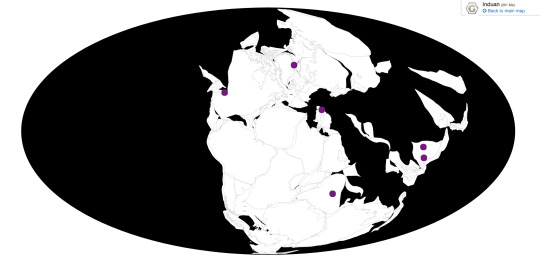#bellerophontid
Explore tagged Tumblr posts
Text
Bellerophon

By Ripley Cook
Etymology: Bellerophon, for the Greek mythological hero
First Described By: Montfort, 1808
Classification: Biota, Archaea, Proteoarchaeota, Asgardarchaeota, Eukaryota, Neokaryota, Scotokaryota Opimoda, Podiata, Amorphea, Obazoa, Opisthokonta, Holozoa, Filozoa, Choanozoa, Animalia, Eumetazoa, Parahoxozoa, Bilateria, Nephrozoa, Protostomia, Spiralia, Platytrochozoa, Lophotrochozoa, Mollusca, Conchifera, Gastropoda, Bellerophontida, Bellerophontina, Bellerophontoidea, Bellerophontidae, Bellerophontinae
Referred Species: Too many to list here
Status: Extinct
Time and Place: 453 to 251 million years ago, from the Katian of the Late Ordovician to the Induan of the Early Triassic.

In the Triassic, Bellerophon is known from Wyoming, Greenland, Italy, China, and eastern Russia.

Physical Description: What is it? It’s a snail. The only fossil remains we have of it are shells, which are wide, coiled, and may or may not have external ribbing. Unlike many modern snails, the coiling did not lean to one side. It superficially resembles the shell of a nautilus, but lacked the complex inner chambering cephalopod shells have. The interior of the shell was simply one large open space in which the snail’s body would have coiled. There would have been plenty of it outside the shell, though; the head, of course, and a large muscular foot which which it moved. With Bellerophon in particular, a good amount of the mantle and foot was exposed, and covered part of the outside of the shell. This was common among bellerophontidans.
Diet: Bellerophon’s diet is unknown. Modern marine snails can eat pretty much anything, so nothing is really out of the question for Bellerophon.
Behavior: Bellerophon probably lived like most snails today: slowly crawling across the seafloor, eating without a care in the world. As a large portion of the mantle was exposed, it may have had difficulty retreating into its shell when threatened by predators. Thus, it likely burrowed into the sandy seafloor to avoid predators, like some marine snails do today.
Ecosystem: Bellerophon lived in shallow marine habitats. It lived alongside brachiopods, bivalves, other gastropods (including other bellerophontids), and ammonites. Bellerophon-containing rocks do not contain a lot of charismatic vertebrate taxa (in part because a lot of charismatic vertebrate taxa were freshly dead).
Other: There’s quite a bit of discourse over which species actually belong to Bellerophon. A few Triassic species have been moved to Retispira. Dicellonema may or may not belong to Bellerophon. There’s even been an older hypothesis that Bellerophon wasn’t a snail at all, but a more basal mollusk (in the likely polyphyletic “Monoplacophora”). This sort of taxonomic minutiae is 60% of what mollusk paleontologists talk about. For the purposes of this article, we’re adopting a more sensu lato Bellerophon.
Why am I writing about this random snail? Because this genus was incredibly long-lived. It first evolved in the late Ordovician. The ORDOVICIAN! And amazingly enough, this genus survived the Permian-Triassic extinction. It lasted for just over 200 million years. Aaaaand then it died out, along with almost every other bellerophontidan, very shortly afterwards. This is a phenomenon known as dead clade walking - when an event isn’t bad enough by itself to completely wipe out a taxon, but it messes it up badly enough that the taxon is consigned to extinction shortly afterwards. Only a handful of bellerophontidans are found after the Induan, with the very very last possible member of the clade hailing from the Early Jurassic.
In this way, they parallel the fate of the clade’s namesake from Greek mythology: Bellerophon. From humble beginnings, Bellerophon ended up in the service of King Iobates, who wanted him dead (for you see, Bellerophon was accused of lusting after Iobates’ daughter). To get rid of him without killing him (because killing your guest would be rude), he was given the task of slaying the three-headed, fire-breathing Chimera. He captured and tamed the winged horse Pegasus, and armed only with his bravery and a block of lead on a stick, he slayed the Chimera. For this he became a famous hero. But the fame got to his head, and one day he tried to ride Pegasus up to Olympus. Zeus was pissed at this, so he sent a gadfly to sting Pegasus. Pegasus bucked Bellerophon off, and he landed on a thorny bush, which broke many of his bones and punctured both of his eyes. He spent the rest of his days morosely wandering the land until his death.
~ By Henry Thomas
Sources Under the Cut
Harper, J.A., Rollins, H.B. 1985. Infaunal or semi-infaunal bellerophont gastropods: analysis of Euphemites and functionally related taa.
Homer. 8th century BC, probably. Iliad.
Kaim, A., Nutzel, A. 2011. Dead bellerophontids walking - The short Mesozoic history of the Bellerophontoidea (Gastropoda). Palaeogeography, Palaeoclimatology, Palaeoecology 308(1-2): 190-199.
Linsley, R.M. 1978. Locomotion rates and shell form in the Gastropoda. Malacologia 17: 193-206.
Smith, W. 1849. Dictionary of Greek and Roman Biography and Mythology.
Yochelson, E.L., Yin, H. (1985). Redesription of Bellerophon asiaticus Wirth (Early Triassic: Gastropoda) from China, and a Survey of Triassic Bellerophontacea. Journal of Paleontology 59(5): 1305-1319.
#bellerophon#bellerophontidan#bellerophontid#gastropod#mollusk#triassic#triassic madness#triassic march madness#paleontology#prehistoric life
109 notes
·
View notes